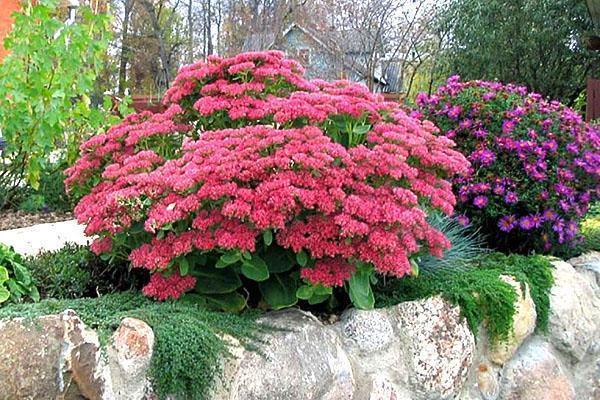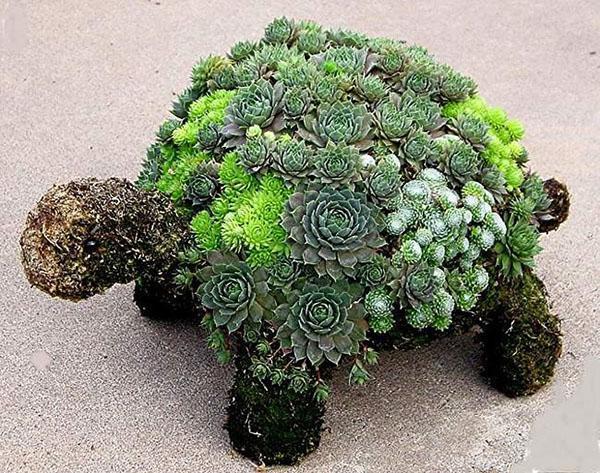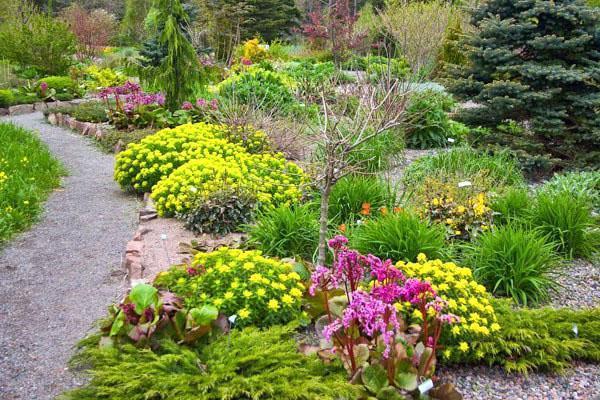Planting and growing an unusual stonecrop in a personal plot
 Sedum is a plant of various shapes and colors, widely used in garden design. If you do the landing and care correctly, sedum will look like in the photo. Most types of stonecrop are ground cover, undersized. The maximum height of the bush is 70 cm. The unpretentious flower is loved by the people, is called feverish, hernial grass, sedum. Grass or shrub grows in soil where other plants do not live. Therefore, it is used in decorative landscaping, hiding unsightly places.
Sedum is a plant of various shapes and colors, widely used in garden design. If you do the landing and care correctly, sedum will look like in the photo. Most types of stonecrop are ground cover, undersized. The maximum height of the bush is 70 cm. The unpretentious flower is loved by the people, is called feverish, hernial grass, sedum. Grass or shrub grows in soil where other plants do not live. Therefore, it is used in decorative landscaping, hiding unsightly places.
Read also the article:hosta planting and care in the open field!
Agrotechnics of sedum
Unpretentious stonecrop plants are found everywhere. They bloom at different times, have a different structure from grass to dwarf shrub. In Russia, sedum is most often found and used in design:
- linear;
- vine-shaped;
- white.
Soil requirement

Stonecrops can grow in one place for up to 5 years, then the curtain must be planted and sprinkled with fresh earth, sand, rubble, depending on the composition created. When planting, the soil is enriched with sand and ash. In order for the plants to receive enough nutrition, they are fertilized in small portions, but often with humus and liquid compositions with an organomineral complex. If plant varieties are wintering, then nitrogen can be applied only in spring, so as not to violate resistance to low temperatures. Loosening and weeding of flower beds will add health and beauty to plants. Sedum caustic is the only variety that is poisonous itself and squeezes the weeds out of the garden.
Caustic sedum is called a purifier because it can be used to remove warts. This plant was used by women as a blush, rubbing the juice on the cheeks. The people called him living water for the extension of female beauty.
The sedum pink stood out as an independent species. Known for its medicinal properties, Rhodiola rosea is also a sedum.
How to care for stonecrop
 The place for stonecrop is chosen to be bright and sunny; you can use it on a rocky and rocky area. Thick, fleshy leaves of stonecrop "tan" and turn reddish at the edges. In the shade, the beauty of stonecrop will fade, the stems are stretched, the leaves become sparse. There are shade-tolerant varieties, but there are few of them.
The place for stonecrop is chosen to be bright and sunny; you can use it on a rocky and rocky area. Thick, fleshy leaves of stonecrop "tan" and turn reddish at the edges. In the shade, the beauty of stonecrop will fade, the stems are stretched, the leaves become sparse. There are shade-tolerant varieties, but there are few of them.
When creating a mesmerizing sedum landscape, as in the photo, planting and leaving is not particularly difficult. However, the plant does not like stagnant water; for the winter, dry stems are cut and even covered in cold regions. In the spring, dried branches are removed or replaced with new plants.
Reproduction of sedums
Before planting stonecrops, it is necessary to clear the site of perennial grasses. The plant propagates by shoots, dividing the bush and seeds.
The easiest way is to dig shoots into clean soil in the spring. They root easily with the cut off aerial part. Root division occurs when long-growing plants need to be planted. They are completely dug out, cut, the sections are dried in the shade for several hours, and only then they are not seated in a new place.The seed method produces an adult flowering plant in two years. Small seedlings with two leaves are immediately planted outside.
Stonecrop spreads along the ground and the stem is gradually bare. The landing view gets messy. The stems can be sprinkled with earth or fine gravel, add humus.
Among insects, stonecrop aphids, sawfly larvae and weevils are harmful. When waterlogged, the plants turn black and fall, affected by rot.
Take a look at the photos of numerous varieties and types of stonecrop
As soon as this unpretentious plant was called! In Germany, he was given the name of a fat hen, in Russia, hare cabbage. All varieties have fleshy leaves that allow the plant to do without watering for a long time. The genus of succulents has 500 species. In the middle lane, about a hundred varieties are cultivated:
- Sedum groundcover thorn-shaped in the floor bowl in the photo is a dense turfed carpet up to 15 cm high. The leaves are fleshy, cylindrical, bluish-green. It grows in rock crevices in the highlands. Found in the wild in the Caucasus. All types of creeping sedum are unpretentious, content with low light, bloom all summer and winter well. In the flowerbed, this is the background on which tall flowers flaunt.

- Sedum is a prominent tall plant with straight stems. Leaves with a bluish bloom are located throughout the stem. Small fluffy pink flowers are collected in a basket up to 15 cm in diameter. Some varieties have white and red baskets. Stonecrop blooms in autumn, before frost. Sedum looks very picturesque in garden compositions.

- Sedum purple grows everywhere in Russia. Rabbit cabbage blooms at the very beginning of autumn, when the rest of the flowers wither. Straight stems raise the fluffy basket 30 cm above the ground. Thick leaves with a waxy coating retain moisture. Hibernates without shelter.

- The sedum of morgana has a completely unusual appearance of leaves on long shoots. Such a plant looks beautiful in hanging flowerpots, when branches with garlands of barrel leaves go down. In Mexico, where the flower comes from, it was nicknamed the monkey's tail.

- Sedum, caustic, is very poisonous and is used in medicine. In nature, it grows near a river, on sandbanks or in a pine forest. The leaves are oval, the flowers are like a star, only yellow. Sedum blooms for one month at the very end of summer. The plant is 10 cm high and tightly covers the soil. This type of stonecrop grows only in an open place.

- False sedum got its name because, even dry, it seems alive, but the rug becomes prickly. The flower is drought-resistant, does not require watering. Decorative hybrids were obtained on the basis of false sedum, but they are less stable and have signs of degeneration. It is this species that never gets sick, and insect pests do not inhabit it.

A selection of photos of sedum in garden design
When creating a garden composition, the designer takes into account many factors. It is important for him that the plants are in harmony. Sedum of various types is irreplaceable in the decoration of gardens. The plant is evergreen, winter-hardy and undemanding in care, it is used as a bright spot or creates a background.
The main condition is that sedum loves open spaces. Let it be a slope, a rock or alpine slide, it would be light. Greening of roofs, decoration of rock gardens - this hardy perennial is irreplaceable everywhere. The designer is faced with the task of choosing stonecrops most successfully in accordance with the artist's intention. See: hosta flower photo
Classic of the last century

Arsene Castle Garden

Modern manor

Original project

Sedum on the hill

Stones in the green sedum

The design of garden compositions is not complete without stonecrops. Unpretentious ground cover varieties are used to decorate the roof of small forms, to create architectural compositions. Bright greens of different shades create a unique look according to the artist's plan. Stonecrops are used both in suspended structures and in a rock garden.In spring, when there is little greenery, sedums enliven the garden, in autumn they bloom and play with colors.